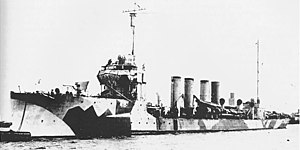USS Jenkins (DD-42)

USS Jenkins (DD-42) moored in a European area port (possibly Queenstown, Ireland), circa 1918. She is painted in "Dazzle" type camouflage.
|
|
| History | |
|---|---|
|
|
|
| Name: | Jenkins |
| Namesake: | Rear Admiral Thortan A. Jenkins |
| Builder: | Bath Iron Works, Bath, Maine |
| Cost: | $650,712.43 |
| Laid down: | 24 March 1911 |
| Launched: | 29 April 1912 |
| Sponsored by: | Miss Alice Jenkins, daughter of Rear Admiral Jenkins |
| Commissioned: | 15 June 1912 |
| Decommissioned: | 31 October 1919 |
| Struck: | 8 March 1935 |
| Identification: |
|
| Fate: | sold for scrap in 1935 |
| Status: | scrapped in 1935 in accordance with the terms of the London Treaty for the Limitation and Reduction of Naval Armaments |
| General characteristics | |
| Class and type: | Paulding-class destroyer |
| Displacement: |
|
| Length: | 293 ft 10 in (89.56 m) |
| Beam: | 27 ft (8.2 m) |
| Draft: | 8 ft 4 in (2.54 m) (mean) |
| Installed power: | 12,000 ihp (8,900 kW) |
| Propulsion: |
|
| Speed: |
|
| Complement: | 4 officers 87 enlisted |
| Armament: |
|
The first USS Jenkins (DD-42) was a modified Paulding-class destroyer in the United States Navy during World War I. She was named for Rear Admiral Thortan A. Jenkins.
Jenkins was laid down on 24 March 1911 by Bath Iron Works, Bath, Maine; launched on 29 April 1912; sponsored by Miss Alice Jenkins, daughter of Rear Admiral Jenkins; and commissioned on 15 June 1912, Lieutenant Commander E. H. Delany in command.
In the years that preceded World War I, Jenkins, based at Newport, Rhode Island, trained with the Atlantic Fleet, sailing to the Caribbean for winter maneuvers operating along the East Coast in summer. In addition, she sailed to Tampico, Mexico in mid-April 1914 to support the American occupation of Veracruz.
As the war raged in Europe, Jenkins continued patrol operations along the North American coast in search of possible German U-boats. The patrols and maneuvers sharpened her war-readiness, so that she was ready for any eventuality when she sailed for Europe on 26 May 1917.
Based at Queenstown, Ireland, Jenkins and her sister destroyers patrolled the eastern Atlantic, escorting convoys and rescuing survivors of sunken merchantmen. She continued escort and patrol duty for the duration of the war. Though she made several submarine contacts, no results were determined. Following the signing of the Armistice on 11 November 1918, Jenkins sailed for home, arriving Boston, Massachusetts on 3 January 1919.
...
Wikipedia
